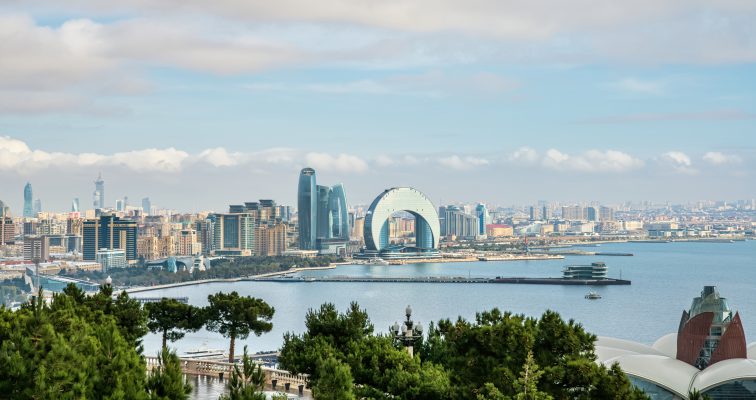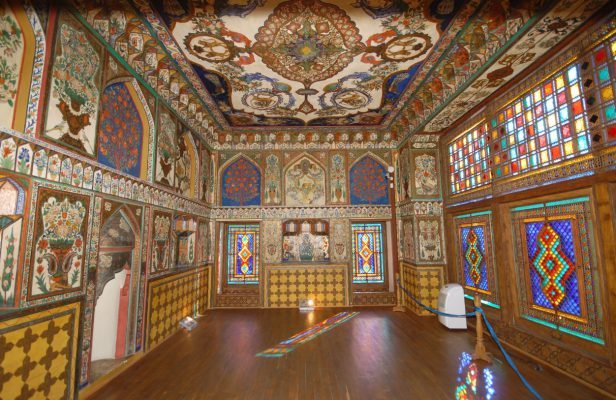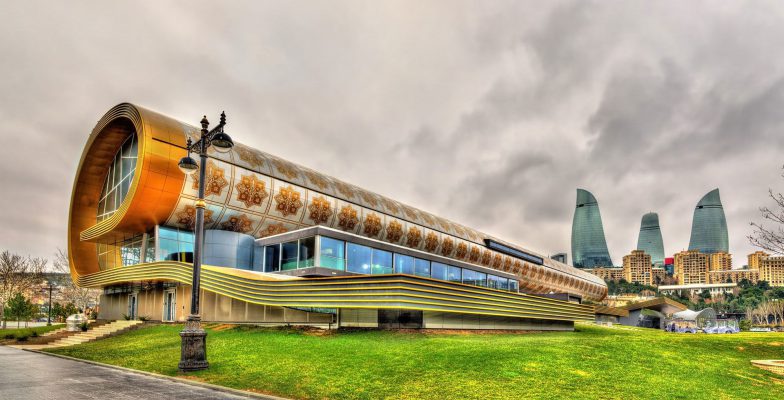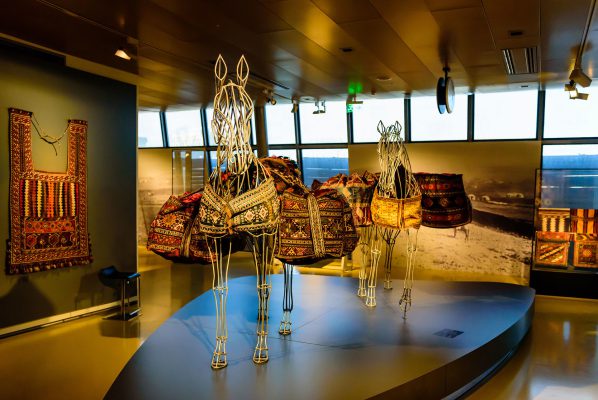On Wednesday March 18, 2025 we left with a selected group of friends for a private tour, initiated by Nanda Jagusiak-Monteiro to Azerbaijan. This trip was organized in collaboration with the Embassy of Azerbaijan in The Hague. They advised me a very good travel agency called All Travel in Baku and for the logistics, I worked with Tika Tours in Amsterdam. We flew with Lufthansa and were picked up by the experienced guide Nurlan. He brought us to our nice 4-star Hotel Sapphire Baiyl in Baku.
On Thursday, with our guide Nurlan, we started with a city tour along the harbor of Baku, the boulevard along the Caspian Sea and passed the Martyr’s Lane. We walked through the old city of Baku, called Icherisheher, which is surrounded by medieval walls resembling a citadel. Icherisheher is a rare pearl of ancient cultural heritage of the Azerbaijani people, included on the UNESCO World Heritage List. Here in a small area of 22,1 hectares, you can see hundreds of historical monuments. You will find a large number of old houses inhabited by more than 1,300 families. Within the Citadel we visited the 15th century Shirvanshahs Palace and the Maiden Tower. The palace served as a residential mansion for the Muslim dynasty of the kings of Shirvan. The palace was erected in the 12th century and the Palace complex is located on three inner courtyards located at different levels. The Palace and the tomb of Shirvanshah Farrukh Yasar are located on the upper courtyard. On the lower level, we could see a bath and an indoor well called “ovdan”. The Maiden Tower has been for many centuries the most prominent piece of the Baku panorama and stands as a 28-meter cylinder. The thickness of the tower walls is 5 meters at the base and 4 meters on the 8th floor. The Maiden Tower was constructed in the 8th-7th centuries B.C. The original function of the tower is speculated as being a Zoroastrian Temple. Scientists have many hypotheses but they all agree, that it has served different purposes at different times, like an observatory, a lighthouse, and as a defense system for the State of Shirvanshahs. Despite numerous attempts, the enemy never captured the Tower. Then we walked to the Muhammad Mosque. This mosque was built by Ustad Ar-rais Muhammad ibn Abu Bakr, dated 1079 AD. In 1723 Russian ships bombed the city from the sea and one of the cannonballs destroyed the minaret. But at the same time a storm wind rose and pushed Russian ships far away from the coastal area. Since then, and until the middle of the 19th century, the mosque stood as a symbol of resistance and courage. The Museum of Miniature Books has the largest collection miniature books in the world. The creator of the museum is Zarifa Salakhova and the museum contains over 6500 books published in more than 67 countries in the world (the current standards of miniature books are 75 x 75 mm and below). We even could admire Dutch miniature books. For dinner we went to a typical Azerbaijani restaurant called Shirvanshah Museum with folk music and we could enjoy the variety of Azerbaijani dishes and wines.
On Friday, we drove to the Absheron Peninsula, nearby the village of Mehemmedi, to a mountain called Yanardag, literally means “burning mountain”, where we could see the eternal flames. In some places the natural gas seeps out to the surface, thus forming islands of perpetual fire. The slopes of the hill have been covered with flames, one meter high and ten meters wide. The natural phenomenon which was also described by Marco Polo, is due to a leakage of flammable natural gas from a large deposit under the Absheron Peninsula. Azerbaijan has been called the Land of Fire since ancient times. Then we visited the Ateshgah Temple of Fire, situated nearby the Surakhani village. Fire worshipers speak about a different epoch, when Zoroastrianism was practiced in this region. The modern constructions date back to the 17th century, built by a Baku-based Hindu community. Scientists found artifacts here that even belonged to earlier periods. It is assumed that the first sanctuary of Zoroastrian fire worshipers was built in Surakhani. Ateshgah is also on the UNESCO World Heritage List. Around the temple are situated many small houses (Caravanserai), in the old days located on the silk route.
After enjoying the Absheron tour, we proceeded to the Heydar Aliyev Center. Built in 2012 by the famous Iraqi-British architect Zaha Hadid, the Center has become one of the main symbols of present-day Baku and won the Design of the Year award in 2014. The Center’s building hardly includes any straight lines. The wave-shaped building represents not only the postmodernist style of architecture but also symbolizes duration and infinity. The Center houses many permanent and temporary art galleries and museums. This is a most wonderful breathtaking building. The next stop was the Baku’s Yashil Bazaar (green bazaar), one of the largest food bazaars in the Caucasus, where we could explore a world of Azerbaijani tastes and aromas.
Then we drove to Highland Park (one of the highest points of the city) where we could see the impressive Flame Towers. These three buildings are the most evident testament to Azerbaijan’s oil boom. The three towers reflect the country’s long-standing devotion to fire, a symbol of cultural significance echoing pre-Islamic Zoroastrian beliefs. We walked through the Alley of Martyrs, a cemetery and memorial site dedicated to the victims of Soviet repression and the First Nagorno-Karabakh War. We reached the terrace with the eternal flame where we had a panoramic view over the city.
In the evening, we were welcomed in the villa of the Nobel Brothers’ House Museum called Villa Petrolea(from the Nobel Prize), which at a special request was opened for our group. The Nobel brothers made an exceptional contribution to the oil industry in Azerbaijan. We learned about the lifestyle of Baku’s turn-of-the-century oil magnates and felt the atmosphere of that time. We could admire the beautiful villa of the Nobel Brothers, their personal belongings, the antique furniture, paintings, photo’s, etc. After our tour, we were treated with champagne and the tasting of black caviar in a beautiful decorated dinner room, where we were welcomed by the managing director Mrs. Gunel Najafova of All Travel. She offered us all a box of baklava. Then followed an exclusive, gastronomical Azerbaijan dinner with many courses and on the background a beautiful lady was playing classical music on the piano. This was an unforgettable evening.
On Saturday, we drove to Absheron, Gobustan high in the mountains to see the eruptions of the mud volcanoes, accompanied by underground rumbles. Gases come out from the deep layers of the earth and we could see the mud bubbling. It is fascinating to see that the earth comes to life.
From there, we drove to the spectacular Gobustan State Historical Artistic Reserve, which is included in the UNESCO World Heritage list. It is an amazing place which took us to a prehistoric era. The Reserve which covers the area of 537 ha, contains one of the world’s largest collections of ancient petroglyphs (more than 4,000 petroglyphs). We started with the museum, which houses more than 100.000 archaeological artifacts, which belonged to the Paleolithic, Mesolithic and Neolithic eras. Then we went to the Reserve where we could admire in the rocks the remains of a large prehistoric complex, even evidence dating back to the Stone Age and a stone slab with a Latin inscription, left by the XII Roman legion of Emperor Domitian, it testifies to the legion’s presence here. We admired beautiful carvings of all kind of animals, ships, warriors, hunting scenes, ritual dances as far as 12.000 years ago. It was quite spectacular.
On Saturday, we checked out of the hotel and left for Sheki. Our first stop was in Shamakhi, where we visited the Juma Mosque, built in 743. This is one of the oldest and largest Mosque, not only in Azerbaijan but in the entire South Caucasus. Over the years the Mosque survived a series of powerful earthquakes and attacks from the enemy in 1918 and was restored several times. In 2013 the Mosque appeared in its glory again. Then we visited a local house for a Yogurt (“qatiq”) making demonstration, where we tasted the yogurt and were treated with several local sweets, like e.g. baklava.
After this we went to a large wine estate, Shirvan Wines, brand Meysari. We made a tour through the nice estate and the wine factory. It was super modern and one of Azerbaijan’s newest winemakers and the first to be classified as an organic producer by EU certification. This was followed by a wine tasting in a nice cellar at a large beautiful decorated table, where we could try 4 wines, and this accompanied with special dishes. We had a great time. In the evening, we checked in in our nice hotel Macara Palace in Sheki.
On Sunday, we started with the Sheki’s lively bazaar of local farmers full of fresh fruits and vegetables. It was fun to see and interesting to hear the explanation of our guide about all kind of fruits and sweets. Then we went to the historic center of Sheki which is a UNESCO World Heritage Site. There we visited the Sheki Khans Palace, built by Huseynkhan in 1762 which is an outstanding work of medieval architecture. For example, the windows made of colored Venetian glass, consisting of thousand parts are connected together without the use of nails. The interesting wall paintings are from the 18th-19th century. The Palace combines many types of folk arts and crafts. In front of the Palace, you will find two old plane trees (called “chinar”) which were planted in 1530 and are more than 30 meters high. Then we visited the House of the Shekikhanovs, which was built in the 18th century. The interiors are decorated with colorful “shebekes” (stain-glass windows) and wall paintings. Shebeke is a field of decorative applied art requiring great skill. The basement of patterns consists of geometrical ornamental, mostly circular, multi-angular and star-shaped forms. We all went to a Shebeke workshop, located near the Khan’s palace. In shebeke making, craftsmen use bars and laths from certain species of hardwood such as boxwood, walnut tree, beech and oak tree. We learnt how to assemble a small stain-glass window, which was fun.
After a nice lunch, we headed to the Upper Caravanserai. The Sheki Caravanserai is a historical monument constructed in the 18-19th century, which was used for trade. The caravanserai was built in the form of fortified structures with a single gate. During dangerous incidents the gate could be closed, rendering the building impregnable. In fact, in 1859 Alexandre Dumas, the famous French writer, wrote about this Caravanserai when he travelled through the Caucasus in his book “Voyage au Caucase”.
Then with taxi’s, we went to the Kish Temple, from the 1st-5th century. This church is thought to be the church of the Caucasian Albania, the ancient state that covered much of the eastern Caucasus from 3BC to 8AD and archaeologists have unearthed evidence of a cultic site existing here as early as 3,000 BC. The church now functions primarily as a museum featuring Bronze Age ceramics. Near the entrance is a bust of the Norwegian explorer Thor Heyerdahl, a pioneer of research into Caucasian Albany and ancient links between Azerbaijan and Norway. After this visit, we were invited for a Baklava Making demonstration and a traditional tea. In 2012 the Presidents of Azerbaijan and Turkey and their spouses also paid a visit to Kish.
On Monday, we visited the orthodox Saint George Church in the Qax region, where a choir of ladies welcomed us. We could admire many icons of saints in the church. We stopped at the Ulu Bridge, a charming 18thcentury stone bridge across the Kurmukhcha river. The bridge is built on rocky cliffs at the narrowest point of the river, apparently the stones are held together by a mortar made using egg yolk.
Then we were invited by a local family where we were warmly welcomed and treated with quite an extensive lunch with a variety of delicious dishes and wines of this region. We all enjoyed it and had a great time. After the lunch we headed to our hotel in Baku where we arrived quite late.
On Tuesday, in Baku we took a heritage and oil boom tour and started with the world’s first industrial oil driller. This historic site marks the birthplace of the Baku’s oil legacy, setting the stage of the wealth and grandeur that followed. At several places in the area “nodding donkey” oil pumps are still functioning. Then we visited the Azerbaijan carpet museum which was constructed in the shape of a rolled-up carpet. The eye-catching building was designed by the Austrian architect Franz Janz and opened in 2014. The museum displays Azerbaijani carpets and rugs with historical and modern weaving techniques and materials. It was amazing to see the variety of wonderful carpets.We walked then along the city’s stunning architectural gems – opulent mansions, grand palaces and iconic landmarks – all built by the oil tycoons. We passed along beautiful buildings, like the Azerbaijan State Academic Opera and Ballet Theatre (1911), the Gothic inspired Ismailiya Palace, the Institute of Manuscripts (1901), Palace of Happiness (1911), the baroque City Hall, the House of Sadykhov Brothers, the House of Hajinski (1913), etc. Our guide told us the fascinating stories of the powerful families who shaped city’s vibrant history.
We lunched in the center where a lively market (Novruz celebration) took place. After this, we ended our trip by going again to the old city for buying some silk shawls and small carpets. We returned to our hotel and had our last dinner in a nice restaurant. Early next day, we headed to the airport to fly back to Amsterdam.
I want to express my sincere gratitude to the Ambassador of Azerbaijan in the Hague and his staff, Mrs. Gunel J. Najafova, Managing Director of All Travel Azerbaijan and Mrs. Tika Svanidze Vancko of Tika Tours. They organized such a splendid cultural trip, which was a very special, exciting and unforgettable experience. Azerbaijan is worth visiting.
Written by Nanda Jagusiak-Monteiro





